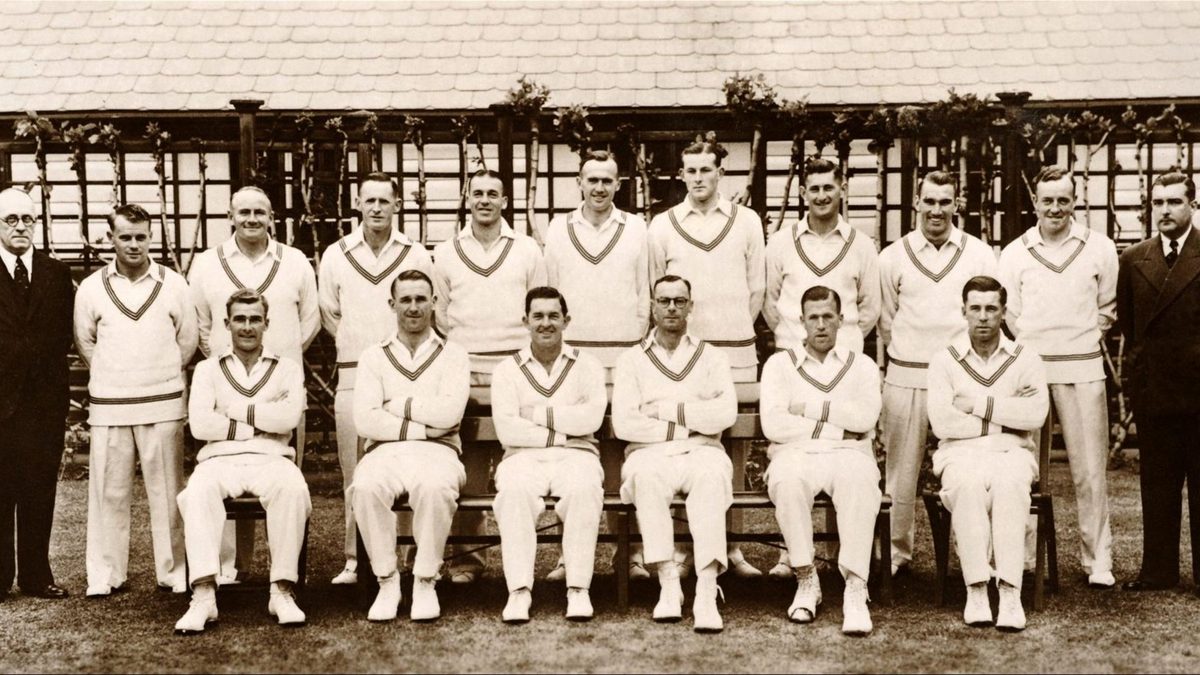
R.C. Robertson-Glasgow paid tribute to Martin Donnelly in the 1950 Wisden Almanack.
Martin Donnelly is seated on the far right of the front row
It is neither fashionable nor always politic to exalt the individual above the team, but in the Test matches between England and New Zealand here in summer 1949 there was one man above all others who stood between England and victory, and that was the left-handed batsman, Martin Paterson Donnelly. He batted at number five. It is a position where the player must be equally able and ready to arrest a decline or to blaze an attack, to be Fabius or Jehu at need and in turn. In this exacting role Martin Donnelly went from triumph to triumph. He was, as it were, both the gum and the glitter; and he carried his burden like a banner.
He is a master of technique. He is never seen to hurry or labour a stroke. As is the habit of the great batsman, he plays the ball very late yet with time to spare. He shows no obvious preference for one sort of stroke or one sort of bowling above another, but he has one gift peculiar to himself, that of flicking the seemingly accurate ball to the leg boundary wide of mid-on. Not even Don Bradman played this stroke with such impudent certainty. Add to all this a solid defence with much speed of foot to smother spin, and you have the complete equipment. Some great left-handers, such as Francis Ford and Frank Woolley, have been notable for the beauty and ease of their play; others, such as Philip Mead and Warren Bardsley, were famous for their solidity and vigilance. Donnelly comes between and sufficiently shares in the art of both these pairs. Further, he has that delight in the high occasion without which art is not transferable into figures.
Donnelly, born on October 17, 1917, began his cricket at a very early age on the home lawn with two elder brothers and his father, who was a good club player. At thirteen he went to the New Plymouth High School. Here he showed almost equal skill at cricket and lawn tennis, and at one time it was doubtful which of these two games would take first place in his ambition. He also captained the Rugby football team, and was later to show such versatility that he played outside-half for Oxford University and centre-threequarter for England. In his last year at school he played for Taranaki against E. R. T. Holmes’s visiting cricketers from England, and helped to save the game with an innings of 49. He was also coached by A. E. Alderman, the Derbyshire professional, and speaks very highly of the encouragement and instruction received. In 1937 he played for Wellington against Auckland in a Plunket Shield match, and soon afterwards was chosen a member of the New Zealand team to tour England under the captaincy of M. L. Page.
It was never the New Zealand way to amass runs for their own sake, but there was something about this nineteen-year-old left-hander that was different. The impetuosity of youth often cost him his wicket, but even in his shorter innings there were already signs of greatness. In the first Test at Lord’s he helped J. L. Kerr to save the match, and in an innings of only 21 showed a cool precision in dealing with bumpers. At Old Trafford, where J. Cowie’s bowling rattled some of the best England batsmen, Donnelly was unbeaten in defeat with 37 not out. At The Oval he scored 58 in the last Test and a brilliant 144 against Surrey. At Leeds he delighted those most phlegmatic and knowing spectators with 97 against Yorkshire. He also made 94 against Warwickshire, which became his own county. His left-hand bowling, of comfortable pace, gained him a few wickets. His fielding and throwing were of the highest quality.
Back in New Zealand for the 1937-38 season he played for Wellington, and seldom scored less than fifty. In the two following years he played for Canterbury, and in the second season he scored 104, 97, 78, 68 and 138 not out in Plunket Shield matches. Meanwhile he had taken his degree at Canterbury University, and soon afterwards went into military camp as a volunteer. He was commissioned in 1941, and went overseas in 1942. In the last gallop to Trieste he commanded a squadron of tanks. His cricket was confined to a few cheerful cow-shots in Cairo.
In May of 1945 Donnelly came to England, and joined the New Zealand Services team under the captaincy of that notable wicket-keeper K. C. James. Matches were played on grounds that varied from the village green to Lord’s. Donnelly had now reached the plenitude of his powers. He played an innings of 100 not out for a New Zealand team against W. R. Hammond’s XI at Edgbaston. Within a space of ten days he scored 133 for the Dominions against England at Lord’s and 100 and 86 for the New Zealanders against H. D. G. Leveson Gower’s XI at Scarborough. Such batting as his and that of Keith Miller, the Australian, were a wonderful sight and a refreshment after six years of war.
In October of that year Donnelly went up to Worcester College, Oxford. In the following summer, 1946, he set a new standard of University batting. He played the professional bowling with almost ludicrous ease. He scored 139 and 45 against Lancashire, l24 against Leicestershire, 117 on a difficult pitch against Gloucestershire and Goddard at Bristol, 116 not out against the touring Indian team, and 101 against Middlesex. Nothing quite like it had been seen before; and the only regret, apart from that suffered by bowlers, was that there were no Test matches in which he was eligible to play. With consummate tact he reserved his very best for the match against Cambridge at Lord’s. W. H. Griffiths, the Cambridge opening bowler, began with much fire and a circle of close fielders. Donnelly, going in at 47 for two wickets, soon hit him for three boundaries. On the Saturday evening he was 29 not out; on the Monday he went on to give an exhibition of such mastery that the elders had to go back to H. K. Foster’s century of forty-one years earlier. He scored 142 in five minutes under three hours, and the pavilion rose to him.
In summer, 1947, he captained Oxford. During the University term he batted as brilliantly as ever, and once more showed his fondness for the Lancashire bowling with an innings of 154 not out. Against Cambridge he played an innings of 81, which was little inferior to his century of the summer before. Ten days later he touched his zenith with 162 not out at Lord’s for Gentlemen versus Players, giving one chance, to slip off Wright, when 39. In the following winter he played Rugby for Oxford against Cambridge and for England against Ireland.
In the next summer, 1948, he played in fifteen matches for Warwickshire, but the claims of business seemed to have taken something from his batting, and his highest score for the county was 96. But at the end of the season he showed his familiar powers in a wonderful innings of 208 not out for M.C.C. v. Yorkshire at Scarborough.
The falling away in his skill was only temporary. When W. A. Hadlee brought his New Zealand team to England in 1949, Donnelly joined them for the tour. He was continually in practice, and in the headlines. It is no exaggeration to say that it was Donnelly’s batting which enabled New Zealand to hold England–anyhow in the first two Tests. At Leeds, when the other batsmen floundered on a difficult pitch against the admirable bowling of T. E. Bailey, Donnelly played with superb skill for 64. Had he failed, New Zealand might well have been out for less than a hundred. This was well done, but better was to come at Lord’s. Here he batted on a true pitch. After a careful start, he steadily but obviously achieved mastery over all the England bowlers, and his 206 must rank among the great Test innings. By this performance he equalled the record of the former Kent and England captain, A. P. F. Chapman. Both these left-handers have scored a century at Lord’s in an Oxford v. Cambridge, a Gentlemen v. Players, and a Test match. He followed this performance with 75 and 80 in the Manchester Test, and his Test average was 77.
Like the other famous New Zealand left-hander, B. Sutcliffe, Donnelly fielded brilliantly throughout the season. A comparison between their batting is inevitable. Sutcliffe perhaps, at his best, has a more powerful ease in his strokes to leg. But, in defence, Donnelly always looked the surer, and no left-hander in our time has excited less expectation in the slips. Indeed, Donnelly’s equipment is complete, for he has courage against speed and a nimble foot against subtlety. His place is undoubtedly among the few truly great players of the present–a view in which I know that another great batsman, W. R. Hammond, concurs.
Besides his skill, Donnelly has a charm, a modesty and a wit which have not always adorned those who keep the turnstiles and the scorers busy.








